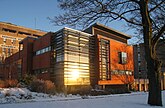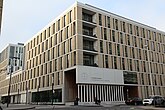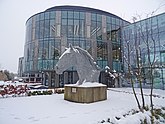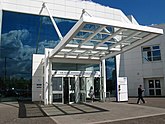
A | B | C | D | E | F | G | H | CH | I | J | K | L | M | N | O | P | Q | R | S | T | U | V | W | X | Y | Z | 0 | 1 | 2 | 3 | 4 | 5 | 6 | 7 | 8 | 9
 | |
| Latin: Universitas Academica Edinburgensis | |
Former names | Tounis College King James' College |
|---|---|
| Type | Public research university Ancient university |
| Established | 1583[1] |
Academic affiliation | |
| Endowment | £559.8 million (2023)[2] |
| Budget | £1.341 billion (2022/23)[2] |
| Chancellor | Anne, Princess Royal |
| Rector | Simon Fanshawe |
| Principal | Sir Peter Mathieson |
Academic staff | 4,952 FTE (2022)[3] |
Administrative staff | 6,215 FTE (2022)[3] |
| Students | 41,250 (2021/22)[4][a] |
| Undergraduates | 26,000 (2021/22)[4] |
| Postgraduates | 15,245 (2021/22)[4] |
| Location | , Scotland, UK 55°57′N 3°11′W / 55.950°N 3.183°W |
| Campus | Urban, suburban |
| Colours | Red Blue[6] |
| Website | www |
 | |

The University of Edinburgh (Scots: University o Edinburgh, Scottish Gaelic: Oilthigh Dhùn Èideann; abbreviated as Edin. in post-nominals) is a public research university based in Edinburgh, Scotland. Founded by the town council under the authority of a royal charter from King James VI in 1582 and officially opened in 1583, it is one of Scotland's four ancient universities and the sixth-oldest university in continuous operation in the English-speaking world.[1] The university played a crucial role in Edinburgh becoming a leading intellectual centre during the Scottish Enlightenment and contributed to the city being nicknamed the "Athens of the North".[7][8]
The three main global university rankings (ARWU, THE, and QS) consistently place the University of Edinburgh within their respective top 30.[9][10] It is a member of several associations of research-intensive universities, including the Coimbra Group, League of European Research Universities, Russell Group, Una Europa, and Universitas 21.[11] In the fiscal year ending 31 July 2023, the university had a total income of £1.341 billion, with £339.5 million from research grants and contracts. It has the third-largest endowment in the UK, behind only Cambridge and Oxford.[2] The university occupies five main campuses in the city of Edinburgh, which include many buildings of historical and architectural significance, such as those in the Old Town.[12]
Edinburgh is the eighth-largest university in the UK by enrolment and receives over 69,000 undergraduate applications per year, making it the third-most popular university in the UK by application volume.[13] In 2021, Edinburgh had the seventh-highest average UCAS points among British universities for new entrants. The university maintains strong links to the royal family, with Prince Philip, Duke of Edinburgh, serving as its chancellor from 1953 to 2010, and Anne, Princess Royal, holding the position since March 2011.[14]
Notable alumni of the University of Edinburgh include inventor Alexander Graham Bell, naturalist Charles Darwin, philosopher David Hume, physicist James Clerk Maxwell, and writers such as Sir J. M. Barrie, Sir Arthur Conan Doyle, J. K. Rowling,[15] Sir Walter Scott, and Robert Louis Stevenson.[16][17] The university has produced several heads of state and government, including three British prime ministers. Additionally, three UK Supreme Court justices were educated at Edinburgh. As of January 2023, the university has been affiliated with 19 Nobel Prize laureates, four Pulitzer Prize winners, three Turing Award winners, an Abel Prize laureate, and a Fields Medalist. Edinburgh alumni have also won a total of ten Olympic gold medals.
History
Early history

In 1557, Bishop Robert Reid of St Magnus Cathedral on Orkney made a will containing an endowment of 8,000 merks to build a college in Edinburgh.[18] Unusually for his time, Reid's vision included the teaching of rhetoric and poetry, alongside more traditional subjects such as philosophy.[18] However, the bequest was delayed by more than 25 years due to the religious revolution that led to the Reformation Parliament of 1560.[18] The plans were revived in the late 1570s through efforts by the Edinburgh Town Council, first minister of Edinburgh James Lawson, and Lord Provost William Little.[1] When Reid's descendants were unwilling to pay out the sum, the town council petitioned King James VI and his Privy Council. The King brokered a monetary compromise and granted a royal charter on 14 April 1582, empowering the town council to create a college of higher education.[18][19][20] A college established by secular authorities was unprecedented in newly Presbyterian Scotland, as all previous Scottish universities had been founded through papal bulls.[21]


Named Tounis College (Town's College), the university opened its doors to students on 14 October 1583, with an attendance of 80–90.[1] At the time, the college mainly covered liberal arts and divinity.[22][23] Instruction began under the charge of a graduate from the University of St Andrews, theologian Robert Rollock, who first served as Regent, and from 1586 as principal of the college.[24] Initially Rollock was the sole instructor for first-year students, and he was expected to tutor the 1583 intake for all four years of their degree in every subject. The first cohort finished their studies in 1587, and 47 students graduated (or 'laureated') with an M.A. degree.[24] When King James VI visited Scotland in 1617, he held a disputation with the college's professors, after which he decreed that it should henceforth be called the "Colledge of King James".[25][26] The university was known as both Tounis College and King James' College until it gradually assumed the name of the University of Edinburgh during the 17th century.[22][27]
After the deposition of King James II and VII during the Glorious Revolution in 1688, the Parliament of Scotland passed legislation designed to root out Jacobite sympathisers amongst university staff.[28] In Edinburgh, this led to the dismissal of Principal Alexander Monro and several professors and regents after a government visitation in 1690. The university was subsequently led by Principal Gilbert Rule, one of the inquisitors on the visitation committee.[28]
18th and 19th century
"You are now in a place where the best courses upon earth are within your reach... Such an opportunity you will never again have. I would therefore strongly press on you to fix no other limit to your stay in Edinborough than your having got thro this whole course. The omission of any one part of it will be an affliction & loss to you as long as you live."
Thomas Jefferson, writing to his son-in-law Thomas Mann Randolph, Jr. in 1786.[29]
The late 17th and early 18th centuries were marked by a power struggle between the university and town council, which had ultimate authority over staff appointments, curricula, and examinations.[30] After a series of challenges by the university, the conflict culminated in the council seizing the college records in 1704.[30] Relations were only gradually repaired over the next 150 years and suffered repeated setbacks.
The university expanded by founding a Faculty of Law in 1707, a Faculty of Arts in 1708, and a Faculty of Medicine in 1726.[31] In 1762, Reverend Hugh Blair was appointed by King George III as the first Regius Professor of Rhetoric and Belles-Lettres.[32] This formalised literature as a subject and marks the foundation of the English Literature department, making Edinburgh the oldest centre of literary education in Britain.[33]
During the 18th century, the university was at the centre of the Scottish Enlightenment.[34] The ideas of the Age of Enlightenment fell on especially fertile ground in Edinburgh because of the university's democratic and secular origin; its organization as a single entity instead of loosely connected colleges, which encouraged academic exchange; its adoption of the more flexible Dutch model of professorship, rather than having student cohorts taught by a single regent; and the lack of land endowments as its source of income, which meant its faculty operated in a more competitive environment.[35] Between 1750 and 1800, this system produced and attracted key Enlightenment figures such as chemist Joseph Black, economist Adam Smith, historian William Robertson, philosophers David Hume and Dugald Stewart, physician William Cullen, and early sociologist Adam Ferguson, many of which taught concurrently.[35] By the time the Royal Society of Edinburgh was founded in 1783, the university was regarded as one of the world's preeminent scientific institutions,[36] and Voltaire called Edinburgh a "hotbed of genius" as a result.[37] Benjamin Franklin believed that the university possessed "a set of as truly great men, Professors of the Several Branches of Knowledge, as have ever appeared in any Age or Country".[38] Thomas Jefferson felt that as far as science was concerned, "no place in the world can pretend to a competition with Edinburgh".[39]


In 1785, Henry Dundas introduced the South Bridge Act in the House of Commons; one of the bill's goals was to use South Bridge as a location for the university, which had existed in a hotchpotch of buildings since its establishment. The site was used to construct Old College, the university's first custom-built building, by architect William Henry Playfair to plans by Robert Adam.[40] During the 18th century, the university developed a particular forte in teaching anatomy and the developing science of surgery, and it was considered one of the best medical schools in the English-speaking world.[41] Bodies to be used for dissection were brought to the university's Anatomy Theatre through a secret tunnel from a nearby house (today's College Wynd student accommodation), which was also used by murderers Burke and Hare to deliver the corpses of their victims during the 1820s.[42][43]
The Edinburgh snowball riots of 1838 also known as the 'Wars of the Quadrangle' occurred when University of Edinburgh students engaged in what started as a snowball fight in "a spirit of harmless amusement" before becoming a two-day 'battle' at Old College with local Edinburgh residents on South Bridge which led to the Lord Provost calling from the 79th regiment to be called from Edinburgh Castle to quell the disturbance. This was later immortalised in a 92-page humorous account written by the students entitled The University Snowdrop and then later, in 1853, in a landscape by English artist, Samuel Bough.[44] [45][46]

After 275 years of governance by the town council, the Universities (Scotland) Act 1858 gave the university full authority over its own affairs.[30] The act established governing bodies including a university court and a general council, and redefined the roles of key officials like the chancellor, rector, and principal.[47]

The Edinburgh Seven were the first group of matriculated undergraduate female students at any British university.[48] Led by Sophia Jex-Blake, they began studying medicine at the University of Edinburgh in 1869. Although the university blocked them from graduating and qualifying as doctors, their campaign gained national attention and won them many supporters, including Charles Darwin.[49] Their efforts put the rights of women to higher education on the national political agenda, which eventually resulted in legislation allowing women to study at all Scottish universities in 1889. The university admitted women to graduate in medicine in 1893.[50][51] In 2015, the Edinburgh Seven were commemorated with a plaque at the university,[52] and in 2019 they were posthumously awarded with medical degrees.[53]


Towards the end of the 19th century, Old College was becoming overcrowded. After a bequest from Sir David Baxter, the university started planning new buildings in earnest. Sir Robert Rowand Anderson won the public architectural competition and was commissioned to design new premises for the Medical School in 1877.[54] Initially, the design incorporated a campanile and a hall for examination and graduation, but this was seen as too ambitious. The new Medical School opened in 1884, but the building was not completed until 1888.[55] After funds were donated by politician and brewer William McEwan in 1894, a separate graduation building was constructed after all, also designed by Anderson.[56] The resulting McEwan Hall on Bristo Square was presented to the university in 1897.[57]

The Students' Representative Council (SRC) was founded in 1884 by student Robert Fitzroy Bell.[58][59] In 1889, the SRC voted to establish Edinburgh University Union (EUU), to be housed in Teviot Row House on Bristo Square.[60] Edinburgh University Sports Union (EUSU) was founded in 1866, and Edinburgh University Women's Union (renamed the Chambers Street Union in 1964) in October 1905.[61] The SRC, EUU and Chambers Street Union merged to form Edinburgh University Students' Association (EUSA) on 1 July 1973.[62][63]
20th century
During World War I, the Science and Medicine buildings had suffered from a lack of repairs or upgrades, which was exacerbated by an influx of students after the end of the war.[64] In 1919, the university bought the land of West Mains Farm in the south of the city for the development of a new satellite campus specialising in the sciences.[65] On 6 July 1920, King George V laid the foundation of the first new building (now called the Joseph Black Building), housing the Department of Chemistry.[64] The campus was named King's Buildings in honour of George V.

New College on The Mound was originally opened in 1846 as a Free Church of Scotland college, later of the United Free Church of Scotland.[66] Since the 1930s it has been the home of the School of Divinity. Prior to the 1929 reunion of the Church of Scotland, candidates for the ministry in the United Free Church studied at New College, whilst candidates for the Church of Scotland studied in the university's Faculty of Divinity.[67] In 1935 the two institutions merged, with all operations moved to the New College site in Old Town.[68] This freed up Old College for Edinburgh Law School.[69]
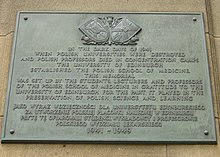
The Polish School of Medicine was established in 1941 as a wartime academic initiative. While it was originally intended for students and doctors in the Polish Armed Forces in the West, civilians were also allowed to take the courses, which were taught in Polish and awarded Polish medical degrees.[70] When the school was closed in 1949, 336 students had matriculated, of which 227 students graduated with the equivalent of an MBChB and a total of 19 doctors obtained a doctorate or MD.[71] A bronze plaque commemorating the Polish School of Medicine is located in the Quadrangle of the old Medical School in Teviot Place.[72]
On 10 May 1951, the Royal (Dick) Veterinary College, founded in 1823 by William Dick,[73] was reconstituted as the Royal (Dick) School of Veterinary Studies and officially became part of the university.[74] It achieved full faculty status as Faculty of Veterinary Medicine in 1964.
In 1955 the university opened the first department of nursing in Europe for academic study. This department was inspired by the work of Gladys Beaumont Carter and a grant from the Rockefeller Foundation.[75]
By the end of the 1950s, there were around 7,000 students matriculating annually, more than doubling the numbers from the turn of the century.[76] The university addressed this partially through the redevelopment of George Square, demolishing much of the area's historic houses and erecting modern buildings such as 40 George Square, Appleton Tower and the Main Library.[77]
On 1 August 1998, the Moray House Institute of Education, founded in 1848, merged with the University of Edinburgh, becoming its Faculty of Education. Following the internal restructuring of the university in 2002, Moray House became known as the Moray House School of Education.[78] It was renamed the Moray House School of Education and Sport in August 2019.[79]
21st century
In the 1990s it became apparent that the old Royal Infirmary of Edinburgh buildings in Lauriston Place were no longer adequate for a modern teaching hospital. Donald Dewar, the Scottish Secretary at the time, authorized a joint project between private finance, local authorities, and the university to create a modern hospital and medical campus in the Little France area of Edinburgh.[80] The new campus was named the BioQuarter. The Chancellor's Building was opened on 12 August 2002 by Prince Philip, housing the new Edinburgh Medical School alongside the new Royal Infirmary of Edinburgh.[81] In 2007, the campus saw the addition of the Euan MacDonald Centre as a research centre for motor neuron diseases, which was part-funded by Scottish entrepreneur Euan MacDonald and his father Donald.[82][83] In August 2010, author J. K. Rowling provided £10 million in funding to create the Anne Rowling Regenerative Neurology Clinic,[84] which was officially opened in October 2013.[85] The Centre for Regenerative Medicine (CRM) is a stem cell research centre dedicated to the development of regenerative treatments, which was opened in 2012.[86] CRM is also home to applied scientists working with the Scottish National Blood Transfusion Service (SNBTS) and Roslin Cells.[87]

In December 2002, the Edinburgh Cowgate Fire destroyed a number of university buildings, including some 3,000 m2 (32,000 sq ft) of the School of Informatics at 80 South Bridge.[88][89] This was replaced with the Informatics Forum on Bristo Square, completed in July 2008. Also in 2002, the Edinburgh Cancer Research Centre (ECRC) was opened on the Western General Hospital site.[90] In 2007, the MRC Human Genetics Unit formed a partnership with the Centre for Genomic & Experimental Medicine and the ECRC to create the Institute of Genetics and Molecular Medicine (renamed the Institute of Genetics and Cancer in 2021) on the same site.[91]
In April 2008, the Roslin Institute – an animal sciences research centre known for cloning Dolly the sheep – became part of the Royal (Dick) School of Veterinary Studies.[92] In 2011, the school moved into a new £60 million building on the Easter Bush campus, which now houses research and teaching facilities, and a hospital for small and farm animals.[93][94]
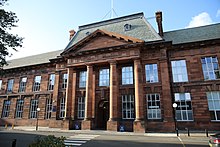
Edinburgh College of Art, founded in 1760, formally merged with the university's School of Arts, Culture and Environment on 1 August 2011.[95][96] In 2014, the Zhejiang University-University of Edinburgh Institute (ZJE) was founded as an international joint institute offering degrees in biomedical sciences, taught in English.[97] The campus, located in Haining, Zhejiang Province, China, was established on 15 March 2016.[98]
The university began hosting a Wikimedian in Residence in 2016.[99] The residency was made into a full-time position in 2019, with the Wikimedian involved in teaching and learning activities within the scope of the University of Edinburgh WikiProject.[100]
In 2018, the University of Edinburgh was a signatory to the £1.3 billion Edinburgh and South East Scotland City Region Deal, in partnership with the UK and Scottish governments, six local authorities and all universities and colleges in the region.[101] The university committed to delivering a range of economic benefits to the region through the Data-Driven Innovation initiative.[102] In conjunction with Heriot-Watt University, the deal created five innovation hubs: the Bayes Centre, Edinburgh Futures Institute (EFI), Usher Institute, Easter Bush, and one further hub based at Heriot-Watt, the National Robotarium. The deal also included creation of the Edinburgh International Data Facility, which performs high-speed data processing in a secure environment.[103][104]
In September 2020, the university completed work on the Richard Verney Health Centre at its central area campus on Bristo Square. The facility houses a health centre and pharmacy, and the university's disability and counselling services.[105] The university's largest current expansion project is the conversion of some of the historic Royal Infirmary of Edinburgh buildings in Lauriston Place, which had been vacated in 2003 and partially developed into the Quartermile. The £120 million renovations and extension will provide space for the Edinburgh Futures Institute, an interdisciplinary hub linking arts, humanities, and social sciences with other disciplines in the research and teaching of 'complex futures'.[106][107]
Historical links
Edinburgh has a number of historical links to other universities, chiefly through its influential Medical School and its graduates, who established and developed institutions elsewhere in the world.
- College of William & Mary: the second-oldest college in the US was founded in 1693 by Edinburgh graduate James Blair, who served as the college's founding president for fifty years.[108]
- Columbia University: had its Medical School founded by Samuel Bard, an Edinburgh medical graduate.
- Dalhousie University: Edinburgh alumnus George Ramsay, the 22nd Lieutenant Governor of Nova Scotia, wanted to establish a non-denominational college in Halifax open to all.[109] The school was modelled after the University of Edinburgh, which students could attend regardless of religion or nationality.[110]
- Dartmouth College: had its School of Medicine founded by Nathan Smith, an alumnus of Edinburgh Medical School.[111]
- Harvard University: had its Medical School founded by three surgeons, one of whom was Benjamin Waterhouse, an alumnus of Edinburgh Medical School.[112]
- McGill University: had its Faculty of Medicine founded by four physicians, which included Edinburgh alumni Andrew Fernando Holmes and John Stephenson.[113][114]
- University of Pennsylvania: had its School of Medicine founded by Edinburgh graduate John Morgan, who modelled it after Edinburgh Medical School.[115][116]
- Princeton University: had its academic syllabus and structure reformed along the lines of the University of Edinburgh and other Scottish universities by its sixth president John Witherspoon, an Edinburgh theology graduate.[117][118]
- University of Sydney: founded in 1850 by Sir Charles Nicholson, a graduate of Edinburgh Medical School.
- Yale University: had its School of Medicine co-founded by Nathan Smith, an alumnus of Edinburgh Medical School.
Campuses and buildings
The university has five main sites in Edinburgh:[119]
- Central Area
- King's Buildings
- BioQuarter
- Easter Bush
- Western General
The university is responsible for several significant historic and modern buildings across the city, including St Cecilia's Hall, Scotland's oldest purpose-built concert hall and the second oldest in use in the British Isles;[120] Teviot Row House, the oldest purpose-built students' union building in the world;[60] and the restored 17th-century Mylne's Court student residence at the head of the Royal Mile.[12]
Central Area

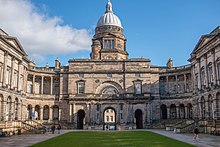

The Central Area is spread around numerous squares and streets in Edinburgh's Southside, with some buildings in Old Town. It is the university's oldest area, occupied primarily by the College of Arts, Humanities and Social Sciences and the School of Informatics. The highest concentration of university buildings is around George Square, which includes 40 George Square (formerly David Hume Tower), Appleton Tower, Main Library, and Gordon Aikman Lecture Theatre, the area's largest lecture hall. Around nearby Bristo Square lie the Dugald Stewart Building, Informatics Forum, McEwan Hall, Potterrow Student Centre, Teviot Row House, and old Medical School, which still houses pre-clinical medical courses and biomedical sciences.[43] The Pleasance, one of Edinburgh University Students' Association's main buildings, is located nearby, as is Edinburgh College of Art in Lauriston. North of George Square lies the university's Old College housing Edinburgh Law School, New College on The Mound housing the School of Divinity, and St Cecilia's Hall. Some of these buildings are used to host events during the Edinburgh International Festival and the Edinburgh Festival Fringe every summer.[121]
Pollock Halls

Pollock Halls, adjoining Holyrood Park to the east, is the university's largest residence hall for undergraduate students in their first year. The complex houses over 2,000 students during term time and consists of ten named buildings with communal green spaces between them.[122] The two original buildings, St Leonard's Hall and Salisbury Green, were built in the 19th century, while the majority of Pollock Halls dates from the 1960s and early 2000s. Two of the older houses in Pollock Halls were demolished in 2002, and a new building, Chancellor's Court, was built in their place and opened in 2003. Self-catered flats elsewhere account for the majority of university-provided accommodation. The area also includes the John McIntyre Conference Centre opened in 2009, which is the university's premier conference space.[123]
Holyrood
The Holyrood campus, just off the Royal Mile, used to be the site for Moray House Institute for Education until it merged with the university on 1 August 1998.[78] The university has since extended this campus.[124] The buildings include redeveloped and extended Sports Science, Physical Education and Leisure Management facilities at St Leonard's Land linked to the Sports Institute in the Pleasance.[125] The £80 million O'Shea Hall at Holyrood was named after the former principal of the university Sir Timothy O'Shea and was opened by Princess Anne in 2017, providing a living and social environment for postgraduate students.[126] The Outreach Centre, Institute for Academic Development (University Services Group), and Edinburgh Centre for Professional Legal Studies are also located at Holyrood.[127][128][129]
King's Buildings

The King's Buildings campus is located in the south of the city. Most of the Science and Engineering College's research and teaching activities take place at the campus, which occupies a 35-hectare site. It includes the Alexander Graham Bell Building (for mobile phones and digital communications systems), James Clerk Maxwell Building (the administrative and teaching centre of the School of Physics and Astronomy and School of Mathematics), Joseph Black Building (home to the School of Chemistry), Royal Observatory, Swann Building (the Wellcome Trust Centre for Cell Biology), Waddington Building (the Centre for Systems Biology at Edinburgh), William Rankine Building (School of Engineering's Institute for Infrastructure and Environment), and others.[130] Until 2012, the KB campus was served by three libraries: Darwin Library, James Clerk Maxwell Library, and Robertson Engineering and Science Library. These were replaced by the Noreen and Kenneth Murray Library opened for the academic year 2012/13.[131][132] The campus also hosts the National e-Science Centre (NeSC), Scotland's Rural College (SRUC), Scottish Institute for Enterprise (SIE), Scottish Microelectronics Centre (SMC), and Scottish Universities Environmental Research Centre (SUERC).
BioQuarter

The BioQuarter campus, based in the Little France area, is home to the majority of medical facilities of the university, alongside the Royal Infirmary of Edinburgh. The campus houses the Anne Rowling Regenerative Neurology Clinic, Centre for Regenerative Medicine, Chancellor's Building, Euan MacDonald Centre, and Queen's Medical Research Institute, which opened in 2005.[81] The Chancellor's Building has two large lecture theatres and a medical library connected to the Royal Infirmary of Edinburgh by a series of corridors.
Easter Bush
The Easter Bush campus, located seven miles south of the city, houses the Jeanne Marchig International Centre for Animal Welfare Education, Roslin Institute, Royal (Dick) School of Veterinary Studies, and Veterinary Oncology and Imaging Centre.[93]
The Roslin Institute is an animal sciences research institute which is sponsored by BBSRC.[133] The Institute won international fame in 1996, when its researchers Sir Ian Wilmut, Keith Campbell and their colleagues created Dolly the sheep, the first mammal to be cloned from an adult cell.[134][135] A year later Polly and Molly were cloned, both sheep contained a human gene.[136]
Western General
The Western General campus, in proximity to the Western General Hospital, contains the Biomedical Research Facility, Edinburgh Clinical Research Facility, and Institute of Genetics and Cancer (formerly the Institute of Genetics and Molecular Medicine).
- Modern architecture at the University of Edinburgh
-
Erskine Williamson Building, King's Buildings
Organisation and administration
Governance
In common with the other ancient universities of Scotland, and in contrast to nearly all other pre-1992 universities which are established by royal charters, the University of Edinburgh is constituted by the Universities (Scotland) Acts 1858 to 1966. These acts provide for three major bodies in the governance of the university: the University Court, the General Council, and the Senatus Academicus.[47]
University Court
The University Court is the university's governing body and the legal person of the university, chaired by the rector and consisting of the principal, Lord Provost of Edinburgh, and of Assessors appointed by the rector, chancellor, Edinburgh Town Council, General Council, and Senatus Academicus. By the Universities (Scotland) Act 1889, it is a body corporate, with perpetual succession and a common seal. All property belonging to the university at the passing of the Act was vested in the Court.[137] The present powers of the Court are further defined in the Universities (Scotland) Act 1966, including the administration and management of the university's revenue and property, the regulation of staff salaries, and the establishment and composition of committees of its own members or others.
General Council
The General Council consists of graduates, academic staff, current and former University Court members. It was established to ensure that graduates have a continuing voice in the management of the university. The Council is required to meet twice per year to consider matters affecting the wellbeing and prosperity of the university. The Universities (Scotland) Act 1966 gave the Council the power to consider draft ordinances and resolutions, to be presented with an annual report of the work and activities of the university, and to receive an audited financial statement.[138] The Council elects the chancellor of the university and three Assessors on the University Court.
Senatus Academicus
The Senatus Academicus is the university's supreme academic body, chaired by the principal and consisting of the professors, heads of departments, and a number of readers, lecturers and other teaching and research staff.[139] The core function of the Senatus is to regulate and supervise the teaching and discipline of the university and to promote research. The Senatus elects four Assessors on the University Court. The Senatus meets three times per year, hosting a presentation and discussion session which is open to all members of staff at each meeting.
University officials
The university's three most significant officials are its chancellor, rector, and principal, whose rights and responsibilities are largely derived from the Universities (Scotland) Act 1858.
The office of chancellor serves as the titular head and highest office of the university. Their duties include conferring degrees and enhancing the profile and reputation of the university on national and global levels.[140] The chancellor is elected by the university's General Council, and a person generally remains in the office for life. Previous chancellors include former prime minister Arthur Balfour and novelist Sir J. M. Barrie.[140] Princess Anne has held the position since March 2011 succeeding Prince Philip.[14] She is also Patron of the university's Royal (Dick) School of Veterinary Studies.
The principal is responsible for the overall operation of the university in a chief executive role.[141] The principal is formally nominated by the Curators of Patronage and appointed by the University Court. They are the President of the Senatus Academicus and a member of the University Court ex officio.[141] The principal is also automatically appointed vice-chancellor, in which role they confer degrees on behalf of the chancellor. Previous principals include physicist Sir Edward Appleton and religious philosopher Stewart Sutherland. The current principal is nephrologist Sir Peter Mathieson, who has held the position since February 2018.[142]
The office of rector is elected every three years by the staff and matriculated students. The primary role of the rector is to preside at the University Court.[143] The rector also chairs meetings of the General Council in absence of the chancellor. They work closely with students and Edinburgh University Students' Association. Previous rectors include microbiologist Sir Alexander Fleming, and former Prime Ministers Sir Winston Churchill and David Lloyd George. The current rector is activist and writer Simon Fanshawe, who has held the position since March 2024.[143][144]
Colleges and schools
In 2002, the university was reorganised from its nine faculties into three 'Colleges'.[145] While technically not a collegiate university, it comprises the Colleges of Arts, Humanities and Social Sciences (CAHSS), Science & Engineering (CSE) and Medicine & Vet Medicine (CMVM). Within these colleges are 'Schools', which either represent one academic discipline such as Informatics or assemble adjacent academic disciplines such as the School of History, Classics and Archaeology. While bound by College-level policies, individual Schools can differ in their organisation and governance. As of 2021, the university has 21 schools in total.[146]
Arts, Humanities and Social Sciences


The College took on its current name of Arts, Humanities and Social Sciences in 2016 after absorbing the Edinburgh College of Art in 2011.[147] CAHSS offers more than 280 undergraduate degree programmes, 230 taught postgraduate programmes, and 200 research postgraduate programmes.[148][149] Twenty subjects offered by the college were ranked within the top 10 nationally in the 2022 Complete University Guide.[150] It includes the oldest English Literature department in Britain,[33] which was ranked 7th globally in the 2021 QS Rankings by Subject in English Language & Literature.[151] The college hosts Scotland's ESRC Doctoral Training Centre (DTC), the Scottish Graduate School of Social Science. The college is the largest of the three colleges by enrolment, with 26,130 students and 3,089 academic staff.[152][5]
- Business School
- Edinburgh College of Art
- Moray House School of Education and Sport
- School of Divinity
- School of Economics
- School of Health in Social Science
- School of History, Classics and Archaeology
- School of Law
- School of Literatures, Languages and Cultures
- School of Philosophy, Psychology and Language Sciences
- School of Social and Political Science
- Centre for Open Learning
- Edinburgh Futures Institute
Medicine and Veterinary Medicine

Edinburgh Medical School was widely considered the best medical school in the English-speaking world throughout the 18th century and the first half of the 19th century and contributed significantly to the university's international reputation.[153][154] Its graduates founded medical schools all over the world, including at five of the seven Ivy League universities (Columbia, Dartmouth, Harvard, Pennsylvania, and Yale); those in McGill, Montréal, Sydney, and Vermont; the Royal Postgraduate Medical School (now part of Imperial College London), Middlesex Hospital, and the London School of Medicine for Women (both now part of UCL).
Zdroj:https://en.wikipedia.org?pojem=Edinburgh_University
Text je dostupný za podmienok Creative Commons Attribution/Share-Alike License 3.0 Unported; prípadne za ďalších podmienok. Podrobnejšie informácie nájdete na stránke Podmienky použitia.
Antropológia
Aplikované vedy
Bibliometria
Dejiny vedy
Encyklopédie
Filozofia vedy
Forenzné vedy
Humanitné vedy
Knižničná veda
Kryogenika
Kryptológia
Kulturológia
Literárna veda
Medzidisciplinárne oblasti
Metódy kvantitatívnej analýzy
Metavedy
Metodika
Text je dostupný za podmienok Creative
Commons Attribution/Share-Alike License 3.0 Unported; prípadne za ďalších
podmienok.
Podrobnejšie informácie nájdete na stránke Podmienky
použitia.
www.astronomia.sk | www.biologia.sk | www.botanika.sk | www.dejiny.sk | www.economy.sk | www.elektrotechnika.sk | www.estetika.sk | www.farmakologia.sk | www.filozofia.sk | Fyzika | www.futurologia.sk | www.genetika.sk | www.chemia.sk | www.lingvistika.sk | www.politologia.sk | www.psychologia.sk | www.sexuologia.sk | www.sociologia.sk | www.veda.sk I www.zoologia.sk





